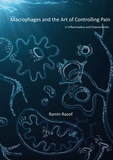Macrophages and the Art of Controlling Pain in Inflammation and Osteoarthritis

Raoof, Ramin
- Promoter:
- Prof.dr F.P.J.G. (Floris) Lafeber & dr N. (Niels) Eijkelkamp
- Co-promoter:
- Dr S.C. (Simon) Mastbergen
- Research group:
- Eijkelkamp , Lafeber
- Date:
- December 11, 2020
- Time:
- 14:30 h
Summary
At first sight chronic pain might seem a pure neurological problem. However, evidence indicates that the immune system contributes in pain pathways. In this thesis, the focus was on elucidating the role of macrophages in 1) transient inflammatory pain where endogenous resolution pathways are active, and 2) chronic osteoarthritis (OA) pain, a pathophysiological condition where pain resolution fails. By understanding how resolution of transient pain is regulated, and learning what goes wrong during chronic pain, we aim to identify highly needed novel options to treat chronic pain.
In this thesis, macrophages were identified as key regulators of pain and that these cells control pain remotely from the site of inflammation or damage. We identified that macrophages, particularly those with the M2 phenotype, control the resolution of pain in a transient inflammatory pain model by a previously unrecognised mechanism, independent of their cytokine release. On the other hand, we showed in a persistent osteoarthritis pain model that macrophages, in this case with the M1 phenotype, have a completely different function and maintain pain. Finally, by inhibiting M1 macrophages in the DRG persisting OA pain was suppressed, indicating that targeting these macrophages is a potential therapeutic approach to treat debilitating pain conditions.
In chapter 2, the role of immune cells and their mediators in regulation of pain is reviewed and evaluated. Here we identified, based on what was already known, that the immune and nervous system closely interact, and that immune cells have important but distinct roles in regulating different types of pain. In this chapter, the role of immune cells is outlined at the different stages during the course of pain including, (i) initiation, (ii) maintenance and (iii) resolution of pain. An overview of their divergent roles in different types of pain and where immune cells modulate pain at different anatomic site in the nervous system is discussed. The contribution of the immune system in pain pathways highlights potential use of immunological approaches to treat chronic pain. However, to optimally develop such strategies we need to have better understanding as to how immune cells control pain. In the following chapters we focused on macrophages and studied whether and how they contribute to endogenous pain resolution pathways, and conversely, whether these plastic cells regulate the initiation and maintenance of chronic osteoarthritis pain. In chapter 3, we showed macrophages accumulate in the dorsal root ganglia during the resolution of inflammatory pain and acquire a M2-like phenotype. By cell-specific depletion and adoptive transfer studies we determined that macrophages actively resolve inflammatory pain. The pain resolving phenotype of macrophages is restricted to M2-like macrophages. To resolve pain, macrophages transfer functional mitochondria in vesicles to DRG sensory neurons. This transfer requires expression of CD200R on vesicles released by macrophages and the CD200R-ligand iSec1 on sensory neurons. Our data in this chapter revealed a mechanism governing the active resolution of inflammatory pain.
The finding that macrophage resolve pain made us wonder whether macrophages, the other way around, also contribute to chronic pain, in particular persisting pain caused by osteoarthritis. In chapter 4, we investigated the role of macrophages in the regulation of persistent OA pain. We unravelled that during the course of OA, macrophages accumulate in the DRG innervating the damaged OA affected knee, and acquire a M1-like phenotype and maintain OA pain. In vitro, DRG sensory neurons that innervate the damaged knee program macrophages toward the pain promoting M1 phenotype. Importantly, these DRG macrophages maintain pain independent from the damage of the knee joint. NaV1.8 sensory neurons, so-called nociceptors, that are important for mediating inflammatory pain, were not required for OA pain, nor for the accumulation of M1-like DRG macrophages, indicating that sensory neurons other than nociceptors drive the programming of these macrophages. Finally, inhibition of DRG macrophages by intrathecal injection of either M2 macrophages or a novel fusion protein of IL4 and IL10 (IL4-10 FP), inhibited OA pain. Thus, during OA polarised macrophages maintain pain, and by therapeutically targeting these macrophages OA pain can be treated.
To further understand what causes the accumulation of DRG macrophages we searched for potential factors that drive the attraction of DRG macrophages. In chapter 5, we identified CXCL11 as a main driver for the accumulation of DRG macrophages in OA. We found that macrophages are attracted by CXCL11 already early during development of OA. However, despite their presence very early during the initiation of OA pain, these DRG macrophages are not required for the initiation of pain. CXCL11 is required to attract macrophages to the DRG but not sufficient to program these DRG macrophages into a pain maintaining phenotype. Thus, we postulated that other factors in addition to CXCL11 are required to program macrophages into a pain-promoting phenotype before they will maintain OA pain. Future research has to identify these putative factors required for the programming of the DRG macrophages in OA.
Altogether, in this thesis we elucidated unprecedented roles of macrophages in the regulation of pain. DRG macrophages can have pain promoting or pain resolving functions depending on their phenotype that are likely governed by the DRG milieu. Finally, we showed that in case of chronic pain targeting the polarized DRG macrophages gives an opportunity for novel therapeutic strategies to potentially treat variety types of chronic pain.